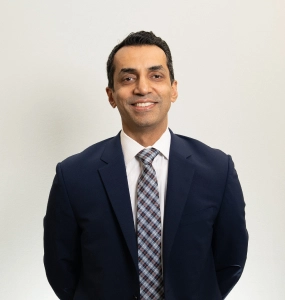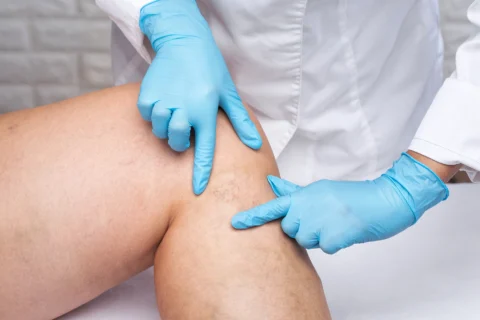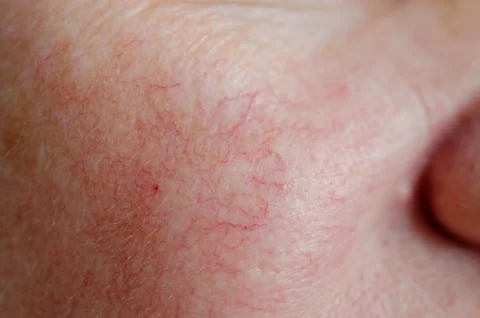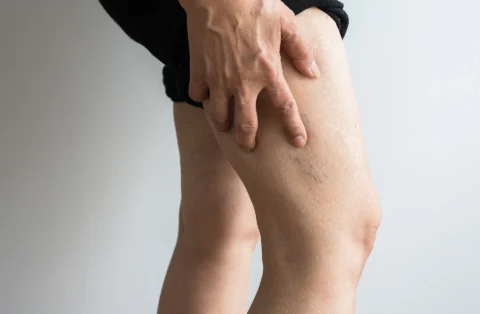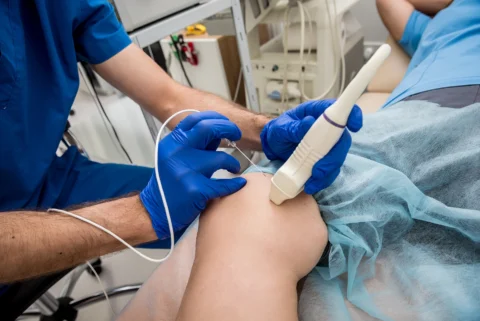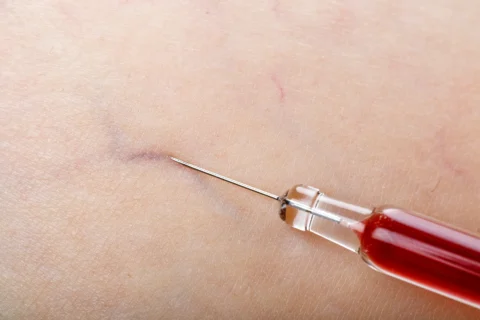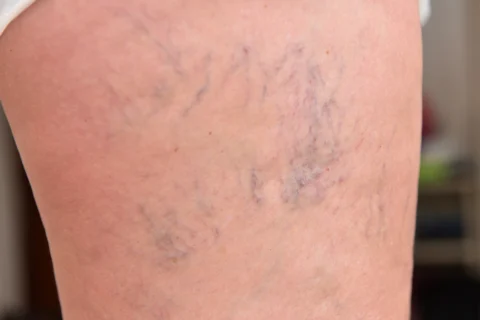A Closer Look at When Spider Veins Typically Develop in Women
Spider veins, also known as telangiectasias, are small, dilated blood vessels that appear close to the surface of the skin. They tend to have a spider web-like appearance, hence the name “spider veins”.
While they can occur anywhere on the body, spider veins most commonly show up on the legs. You might notice them as thin, blue or red lines snaking across your calves or ankles. In some cases, they may branch out into your feet. Spider veins can also appear on your face, particularly around your nose and cheeks.
So what are spider veins exactly? Essentially, they’re varicose vein-lettes. Spider veins form when the tiny one-way valves in your leg veins become faulty or damaged. This causes blood to pool in the veins, making them widen and become more visible through your skin.
Having spider veins is kind of like having a leaky hose. When those little valves fail, the “pressure” in the veins drops and blood flows backward, branching off into smaller veins.
Over time, this backward flow stretches and dilates the vein walls, causing those characteristic “spider web” venous markings you see on people’s legs.
While spider veins are usually just a cosmetic concern, they can be an early sign of “venous insufficiency”. This means the veins in your legs aren’t pumping blood back to your heart as efficiently as they should.
If left untreated, this venous insufficiency could progress and lead to larger varicose veins and more serious health issues down the road.
So keeping an eye on those little spider veins can give you a heads up that it might be time to take some measures to improve your leg vein health and blood flow. Small changes now could help you avoid bigger problems later!
Average Age of Spider Vein Development in Women
While spider veins can form at any age, they become more common as women get older. Here are the typical ages when spider veins tend to appear in women:
- 20s to 30s: Some women start developing spider veins as early as their 20s or 30s. Hormonal changes during puberty and pregnancy can cause veins to enlarge and valves to weaken at a younger age.
- 40s: Many women first notice spider veins popping up around their mid-40s. At this age, both pregnancy and the natural aging process contribute to weakened vein walls and faulty valves.
- 50s to 60s: Over half of all women in their 50s and 60s have spider veins. As women go through menopause, hormone level changes put even more strain on their veins.
- 65 and older: Nearly 75% of women aged 65 and older deal with spider veins. As women age, their vein walls and valves continue to deteriorate from gravity, lack of activity and general wear and tear.
However, genetics also plays a role. If your mother or grandmother had spider veins at a young age, you may be predisposed to getting them earlier in life too. Certain health conditions like obesity can also cause veins to dilate more quickly.
So while spider veins become more common as women age, factors like heredity, hormones and weight can mean some women develop them earlier than average while others avoid them for longer.
The important thing is noticing the signs and taking proactive steps to support your overall vein health at any age. Simple lifestyle changes and compression gear can help keep spider veins – and possibly more serious problems – at bay.
Causes of Spider Veins in Women
Several factors contribute to the development of spider veins in women:
Weakening of vein walls
Over time, the elastic tissue and muscle that make up vein walls start to lose their elasticity and strength. This causes veins to dilate and stretch.
Faulty valves
The one-way valves inside veins also become damaged and lose their ability to hold blood flowing downward. This allows blood to pool and backflow into smaller veins.
Hormonal changes
Hormonal fluctuations during puberty, pregnancy and menopause place extra strain on women’s veins. Changing hormone levels cause veins to widen and weaken much faster.
Genetics
If varicose veins or spider veins run in your family, you’re also more likely to inherit faulty vein valves and stretchy vein walls.
Being overweight
Extra body weight puts extra pressure on leg veins, causing them to bulge and distend earlier than normal.
Lack of activity
Sitting or standing for long periods without moving fails to pump blood back up to the heart through leg veins. This blood pooling further stretches vein walls over time.
Aging
As women age, everything from gravity to decreased mobility to muscle loss contribute to worsening vein health. Spider veins typically become more common and severe after age 50.
Some women are more prone to spider veins than others based on a combination of these factors. But for the vast majority of women, non-modifiable causes like aging and hormones are exacerbated by lifestyle habits that can be improved.
Paying attention to weight, activity levels and sitting/standing times can help offset the natural progression of spider veins that comes with getting older.
Prevention of Spider Veins in Women
While spider veins can’t always be prevented entirely, there are lifestyle changes women can make to help slow their progression and development:
- Exercise regularly: Any kind of activity that gets your heart pumping and your leg muscles working helps stimulate blood flow in your veins. Even walking 30 minutes a day can make a big difference.
- Maintain a healthy weight: Extra body weight puts excess pressure on leg veins. Losing weight (if needed) can reduce this pressure and alleviate vein strain.
- Avoid prolonged sitting or standing: Take regular breaks and movement breaks during periods of prolonged inactivity to encourage blood flow in your legs. Even walking around for a few minutes every hour works wonders.
- Elevate your legs above your heart: Prop your feet up on a stool while watching TV or raise your legs against a wall when lying down. This allows gravity to remove blood from swollen legs and feet.
- Wear compression stockings: Compression socks or stockings provide external support for your vein walls, protecting them from pooling blood and further damage or stretch.
- Stop smoking: Tobacco constricts blood vessels and impairs circulation, both of which speed the development of spider veins.
Making even small tweaks in these areas can pay off big time for women’s vein health as they age. Every little bit of decreased pressure, increased movement and external support for veins helps keep those tiny valves functioning properly and vein walls from weakening prematurely.
Consistently implementing these prevention strategies is key – even if spider veins have already appeared. They could help slow or stop further progression into worse varicose veins down the line.
Treatment Methods for Spider Veins in Women

For women seeking treatment options for existing spider veins, both non-invasive and minimally invasive procedures are available:
Non-invasive options:
- Compression therapy: Wearing medical-grade compression hosiery or sleeves provides around-the-clock support to veins. This can help minimize swelling and further vein dilation.
- Leg elevation: Raising your legs above the level of your heart when sitting or lying down removes excess fluid buildup that contributes to vein pooling.
- Exercise: Any physical activity that promotes blood flow and calf muscle pumping action can improve venous circulation and vein function over time.
- Weight loss: Even a 10% reduction in body weight provides significant relief of venous pressure on overweight or obese women.
Minimally invasive options:
- Sclerotherapy: A liquid solution is injected into spider veins to damage their lining, causing them to collapse and fade over time.
- Laser therapy: A focused light beam is used to heat and seal off spider veins. The treated veins then coil and disappear.
- Radiofrequency ablation: RF energy is delivered to spider veins via a probe, heating and sealing them off.
- Vein removal (phlebectomy): Small incisions are made to physically remove the visible spider veins.
Your doctor can help determine which treatments are best based on the extent and location of your spider veins, your health history and personal priorities.
For women seeking more cosmetic improvement, procedures like sclerotherapy, laser therapy and phlebectomy tend to yield faster, more noticeable results.
However, any treatment that targets the underlying vein problem – even compression therapy – is also important for preventing further vein deterioration that leads to worse symptoms and more severe varicose veins with age.
A multi-pronged approach utilizing both non-invasive lifestyle changes and targeted minimally invasive procedures tends to give women the best long-term outcomes.
Conclusion

Spider veins are a common and often frustrating issue for many women as they age. But while these tiny thread-like veins might seem trivial at first, they can actually signal developing problems in your larger leg vein system.
So while spider veins themselves may simply be an aesthetic concern, they serve as an important reminder to prioritize your overall vein health. Making consistent lifestyle changes and seeking appropriate treatment – from non-invasive compression therapy to minimally invasive procedures – can help address the root causes of spider vein formation.
With a proactive, multi-pronged approach, many women are able to:
- Stall or slow the progression of existing spider veins
- Avoid the development of new spider veins
- Reduce symptoms like leg heaviness, swelling and fatigue
- Possibly prevent larger varicose veins from forming down the road
If spider veins are already impacting your quality of life or you have noticeable symptoms along with them, seeking a professional vein evaluation is advised. A vein specialist can determine the extent of your vein issues, recommend targeted treatments and create an ongoing management plan.
With proper treatment, guidance and diligent self-care, women of any age can support healthy leg veins for decades to come – whether that simply means fewer spider veins or avoiding varicose veins altogether. Paying attention now really does pay off later!
So don’t dismiss those spider-like threads on your legs. Treat them as a wake-up call to empower yourself with knowledge, treatment options and prevention strategies that address your unique concerns and priorities.
